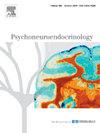CO2 challenge-evoked hormonal changes predicting TSST changes in cortisol and subjective distress
IF 3.4
2区 医学
Q2 ENDOCRINOLOGY & METABOLISM
引用次数: 0
Abstract
The importance of stressor response in relation to the development of psychopathology has been recognized for decades, yet the relationship is not fully understood. The Trier Social Stress Test (TSST) is an established conditioned stressor and frequently used to assess cortisol response to acute stress in different psychopathologies. The 35 % CO2 Challenge is a biological stressor and has mostly been utilized to assess subjective responses in anxiety related disorders. In the current study (N=189), we assessed the hormonal effects (cortisol, testosterone) and subjective distress (stress, anxiety, and fear) of the 35 % CO2 Challenge, and several days later, assessed the hormonal and subjective distress effects of the TSST in a mixed-sex, college-aged sample, to test for predictive effects of the 35 % CO2 Challenge on TSST-evoked outcomes. No testosterone by cortisol interaction effects were found in females. In males, the 35 % CO2 Challenge-evoked interaction of testosterone and cortisol predicted TSST-evoked subjective stress, anxiety, and fear, with higher concentrations of testosterone predicting subjective distress, but only at (relatively) low concentrations of cortisol (one standard deviation below mean concentrations). This result – in line with the dual-hormone hypothesis – suggests the 35 % CO2 Challenge could be utilized in a wider array of laboratory stress response research.
二氧化碳挑战诱发的激素变化可预测皮质醇和主观痛苦的 TSST 变化。
数十年来,人们已经认识到应激反应对心理病理学发展的重要性,但对两者之间的关系还不完全清楚。特里尔社会压力测试(TSST)是一种成熟的条件性压力源,常用于评估皮质醇对不同精神病理学中急性压力的反应。35% CO2 挑战是一种生物应激源,主要用于评估焦虑相关疾病的主观反应。在当前的研究中(N=189),我们评估了 35% CO2 挑战的荷尔蒙效应(皮质醇、睾酮)和主观困扰(压力、焦虑和恐惧),几天后,我们又评估了 TSST 对男女混合的大学年龄样本的荷尔蒙和主观困扰效应,以检验 35% CO2 挑战对 TSST 诱发结果的预测效应。在女性中没有发现睾酮与皮质醇的交互效应。在男性中,35% CO2 挑战诱发的睾酮和皮质醇相互作用可预测 TSST 诱发的主观压力、焦虑和恐惧,较高浓度的睾酮可预测主观痛苦,但只有在(相对)较低的皮质醇浓度(低于平均浓度一个标准差)时才能预测。这一结果与双激素假说一致,表明 35% CO2 挑战可用于更广泛的实验室应激反应研究。
本文章由计算机程序翻译,如有差异,请以英文原文为准。
求助全文
约1分钟内获得全文
求助全文
来源期刊

Psychoneuroendocrinology
医学-精神病学
CiteScore
7.40
自引率
8.10%
发文量
268
审稿时长
66 days
期刊介绍:
Psychoneuroendocrinology publishes papers dealing with the interrelated disciplines of psychology, neurobiology, endocrinology, immunology, neurology, and psychiatry, with an emphasis on multidisciplinary studies aiming at integrating these disciplines in terms of either basic research or clinical implications. One of the main goals is to understand how a variety of psychobiological factors interact in the expression of the stress response as it relates to the development and/or maintenance of neuropsychiatric illnesses.
 求助内容:
求助内容: 应助结果提醒方式:
应助结果提醒方式:


